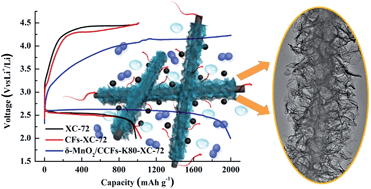The controlled growth of porous δ-MnO2 nanosheets on carbon fibers as a bi-functional catalyst for rechargeable lithium–oxygen batteries†
Abstract
The electrochemical performance of lithium–oxygen (Li–O2) batteries greatly depends on the pore structure and effectiveness of the catalysts used in the oxygen cathode. Herein, porous δ-MnO2/carbon composite fibers (δ-MnO2/CCFs), where the interconnected and ultrathin δ-MnO2 nanosheets are uniformly coated on electrospun carbon fibers (CFs), have been successfully fabricated via a facile liquid deposition. This unique structure ensures the high utilization of the catalytic sites, sufficient spaces to accommodate the discharge products, and rapid diffusion of lithium ions and oxygen within the porous catalyst, thus providing suitable characteristics of an electrocatalyst for high-performance Li–O2 batteries. As a consequence, suppressed overpotentials, especially oxygen evolution reaction overpotential and desirable rate capability are achieved by the Li–O2 cells with these δ-MnO2/CCFs as electrocatalysts. In addition, the effectiveness of the catalyst and its critical role during the electrochemical growth of the discharge product (Li2O2) are further analyzed.


 Please wait while we load your content...
Please wait while we load your content...